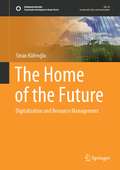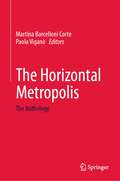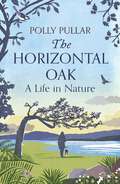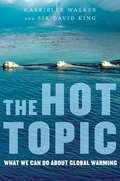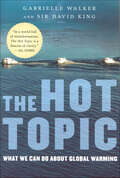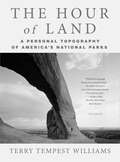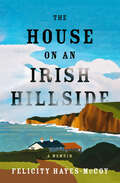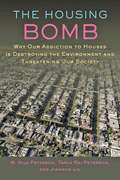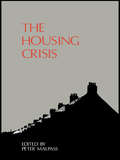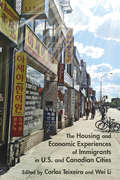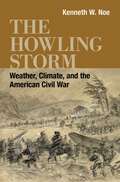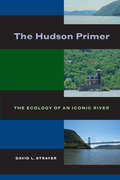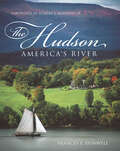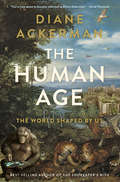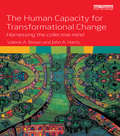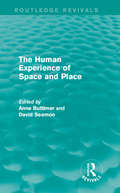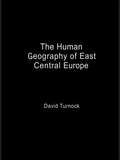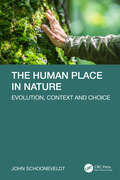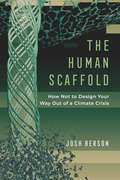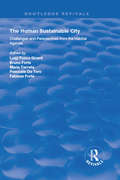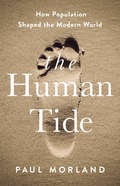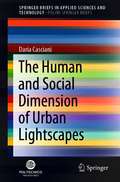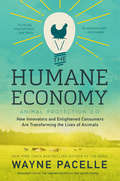- Table View
- List View
The Home of the Future: Digitalization and Resource Management (Sustainable Development Goals Series)
by Sinan KüfeoğluThis book presents an in-depth study to show that a sustainable future urban life is possible. To build a safer and more sustainable future, as humankind, we would like to use more renewable energy, increase energy efficiency, reduce our carbon and water footprints in all economic sectors. The increasing population and humans’ ever-increasing demand for consumption pose another question whether the world’s resources are sufficient for present and future generations. Fair access to water, energy, and food is the objective for all. In line with the United Nations Sustainable Development Goals, scientists, researchers, engineers, and policymakers worldwide are working hard to achieve these objectives. To answer all these challenges, we would like to introduce the core of Smart Cities of the future, the building block of the future’s urban life: Open Digital Innovation Hub (ODIH). ODIH will serve as the ‘Home of the Future’, a fully digitalised and smart, self-sustaining building that answers all the motivation we highlight here. In ODIH, we introduce a living space that produces its water, energy, and food by minimising carbon and water footprints thanks to the Internet of Things, Artificial Intelligence, and Blockchain technologies. It will also serve as an open innovation environment for start-ups and entrepreneurs who wish to integrate their solutions into the infrastructure of ODIH and test those in real-time. We believe this will be a true open innovation test-bed for new business models.
The Horizontal Metropolis: The Anthology
by Paola Viganò Martina Barcelloni CorteThis book draws together classic and contemporary texts on the “Horizontal Metropolis” concept. Taking an interdisciplinary approach, it explores various theoretical, methodological and political implications of the Horizontal Metropolis hypothesis. Assembling a series of textual and cartographic interventions, this book explores those that supersede inherited spatial ontologies (urban/rural, town/country, city/non-city, society/nature). It investigates the emergence of a new type of extended urbanity across regions, territories and continents up to the global scale through the reconstruction of a fundamental but neglected tradition. This book responds to the radical nature of the changes underway today, calling for a rethinking of the Western Metropolis idea and form along with the emergence of new urban paradigms. The Horizontal Metropolis concept represents an ambitious attempt to offer new instruction to take on this challenge at the global scale. The book is intended for a wide audience interested in the emergence and development of new approaches in urbanism, architecture, cultural theory, urban and design education, landscape urbanism and geography.
The Horizontal Oak: A Life in Nature
by Polly PullarPeppered with humour, empathy and kindness' - Sunday Post Ever since her pet sheep Lulu accompanied her to school at the age of seven, animals and nature have been at the heart of Polly Pullar’s world. Growing up in a remote corner of the Scottish West Highlands, she roamed freely through the spectacular countryside and met her first otters, seals, eagles and wildcats. But an otherwise idyllic childhood was marred by family secrets which ultimately turned to tragedy. Following the suicide of her alcoholic father and the deterioration of her relationship with her mother, as well as the break-up of her own marriage, Polly rebuilt her life, earning a reputation as a wildlife expert and rehabilitator, journalist and photographer. This is her extraordinary, inspirational story. Written with compassion, humour and optimism, Polly reflects on how her love of the natural world has helped her find the strength to forgive and understand her parents, and to find an equilibrium.
The Hot Topic: What We Can Do About Global Warming
by Gabrielle Walker David KingA book that explains the science behind global warming, the most cutting-edge technological solutions from small to large, and the national and international politics that will affect our efforts
The Hot Topic: What We Can Do about Global Warming
by Gabrielle Walker David KingOne of the most dynamic writers and one of the most respected scientists in the field of climate change offer the first concise guide to both the problems and the solutions of global warming. Guiding us past a blizzard of information and misinformation, Gabrielle Walker and Sir David King explain the science of warming, the most cutting-edge technological solutions from small to large, and the national and international politics that will affect our efforts. While there have been many other books about the problem of global warming, none has addressed what we can and should do about it so clearly and persuasively, with no spin, no agenda, and no exaggeration. Neither Walker nor King is an activist or politician, and theirs is not a generic green call to arms. Instead they propose specific ideas to fix a very specific problem. Most important, they offer hope: This is a serious issue, perhaps the most serious that humanity has ever faced. But we can still do something about it. And they’ll show us how.
The Hour Of Land: A Personal Topography Of America's National Parks
by Terry Tempest WilliamsAmerica’s national parks are breathing spaces in a world in which such spaces are steadily disappearing, which is why more than 300 million people visit the parks each year. Now Terry Tempest Williams, the New York Times bestselling author of the environmental classic Refuge and the beloved memoir When Women Were Birds, returns with The Hour of Land, a literary celebration of our national parks and an exploration of what they mean to us and what we mean to them. From the Grand Tetons in Wyoming to Acadia in Maine to Big Bend in Texas, Williams creates a series of lyrical portraits that illuminate the unique grandeur of each place while delving into what it means to shape a landscape with its own evolutionary history into something of our own making. Part memoir, part natural history, and part social critique, The Hour of Land is a meditation and a manifesto on why wild lands matter to the soul of America.
The House on an Irish Hillside: A Memoir
by Felicity Hayes-McCoy&“A lovely writer, far superior to the average memoirist. . . . A curious mind, a perceptive observer with an artist&’s eye, a seeker of truth and beauty.&” —Irish IndependentFrom the moment I crossed the mountain, I fell in love with the place, which was more beautiful than any I&’d ever seen. And with a way of looking at life that was deeper, richer and wiser than any I&’d known before. . . . From the first day I came here I always knew I&’d come back. Sometimes we have to go back to our beginnings to become the person we want to be. More than a decade ago, USA Today–bestselling author Felicity Hayes-McCoy left the hectic pace of London and returned to her home country of Ireland to forge a new life in a remarkable house on the stunning Dingle peninsula. Gorgeously written, this is a life-affirming tale of rediscovering lost values and remembering the things that matter most. &“Wise, funny and touching, this book is a portrait of friendships, customs and folklore of Ireland; but what stays with you is harder to catch, like smoke or running water. It is the taste of something we all once knew, ever-present if only you look for it.&” ―Joanna Lumley, actress and author of Absolutely: A Memoir &“The book glowed . . . when I finished reading, I felt a sense of well-being, wonder and delight.&” —Alice Taylor, bestselling author of To School Through the FieldsPraise for Felicity Hayes-McCoy &“A pitch-perfect delight.&” —Marian Keyes, international bestselling author of Grown Ups on The Transatlantic Book Club &“The spot-on descriptions of Ireland&’s country roads and expansive sky all but leap off the page. . . . Maeve Binchy and Patrick Taylor fans will find much to enjoy.&” —Booklist on The Library at the Edge of the World &“Sunshine on the page.&” —Cathy Kelly, bestselling author of Between Sisters on The Month of Borrowed Dreams
The Housing Bomb: Why Our Addiction to Houses Is Destroying the Environment and Threatening Our Society
by Jianguo Liu M. Nils Peterson Tarla PetersonHow our thirst for more and larger houses is undermining society and what we can do about it.Have we built our way to ruin? Is your desire for that beach house or cabin in the woods part of the environmental crisis? Do you really need a bigger home? Why don’t multiple generations still live under one roof? In The Housing Bomb, leading environmental researchers M. Nils Peterson, Tarla Rai Peterson, and Jianguo Liu sound the alarm, explaining how and why our growing addiction to houses has taken the humble American dream and twisted it into an environmental and societal nightmare. Without realizing how much a contemporary home already contributes to environmental destruction, most of us want bigger and bigger houses and dream of the day when we own not just one dwelling but at least the two our neighbor does. We push our children to "get out on their own" long before they need to, creating a second household where previously one existed. We pave and build, demolishing habitat needed by threatened and endangered species, adding to the mounting burden of global climate change, and sucking away resources much better applied to pressing societal needs. "Reduce, reuse, recycle" is seldom evoked in the housing world, where economists predict financial disasters when "new housing starts" decline and the idea of renovating inner city residences is regarded as merely a good cause. Presenting irrefutable evidence, this book cries out for America and the world to intervene by making simple changes in our household energy and water usage and by supporting municipal, state, national, and international policies to counter this devastation and overuse of resources. It offers a way out of the mess we are creating and envisions a future where we all live comfortable, nondestructive lives. The "housing bomb" is ticking, and our choice is clear—change our approach or feel the blast.
The Housing Crisis
by Mr David AlexanderFirst published in 1986. Routledge is an imprint of Taylor & Francis, an informa company.
The Housing and Economic Experiences of Immigrants in U.S. and Canadian Cities
by Wei Li Carlos TeixeiraSince the 1960s, new and more diverse waves of immigrants have changed the demographic composition and the landscapes of North American cities and their suburbs. The Housing and Economic Experiences of Immigrants in U.S. and Canadian Cities is a collection of essays examining how recent immigrants have fared in getting access to jobs and housing in urban centres across the continent.Using a variety of methodologies, contributors from both countries present original research on a range of issues connected to housing and economic experiences. They offer both a broad overview and a series of detailed case studies that highlight the experiences of particular communities. This volume demonstrates that, while the United States and Canada have much in common when it comes to urban development, there are important structural and historical differences between the immigrant experiences in these two countries.
The Howling Storm: Weather, Climate, and the American Civil War (Conflicting Worlds: New Dimensions of the American Civil War)
by Kenneth W. NoeTraditional histories of the Civil War describe the conflict as a war between North and South. Kenneth W. Noe suggests it should instead be understood as a war between the North, the South, and the weather. In The Howling Storm, Noe retells the history of the conflagration with a focus on the ways in which weather and climate shaped the outcomes of battles and campaigns. He further contends that events such as floods and droughts affecting the Confederate home front constricted soldiers’ food supply, lowered morale, and undercut the government’s efforts to boost nationalist sentiment. By contrast, the superior equipment and open supply lines enjoyed by Union soldiers enabled them to cope successfully with the South’s extreme conditions and, ultimately, secure victory in 1865. Climate conditions during the war proved unusual, as irregular phenomena such as El Niño, La Niña, and similar oscillations in the Atlantic Ocean disrupted weather patterns across southern states. Taking into account these meteorological events, Noe rethinks conventional explanations of battlefield victories and losses, compelling historians to reconsider long-held conclusions about the war. Unlike past studies that fault inflation, taxation, and logistical problems for the Confederate defeat, his work considers how soldiers and civilians dealt with floods and droughts that beset areas of the South in 1862, 1863, and 1864. In doing so, he addresses the foundational causes that forced Richmond to make difficult and sometimes disastrous decisions when prioritizing the feeding of the home front or the front lines. The Howling Storm stands as the first comprehensive examination of weather and climate during the Civil War. Its approach, coverage, and conclusions are certain to reshape the field of Civil War studies.
The Hudson Primer: The Ecology of an Iconic River
by David L. StrayerThis succinct book gives an intimate view of the day-to-day functioning of a remarkable river that has figured prominently in history and culture--the Hudson, a main artery connecting New York, America, and the world. Writing for a wide audience, David Strayer distills the large body of scientific information about the river into a non-technical overview of its ecology. Strayer describes the geography and geology of the Hudson and its basin, the properties of water and its movements in the river, water chemistry, and the river's plants and animals. He then takes a more detailed look at the Hudson's ecosystems and each of its major habitats. Strayer also discusses important management challenges facing the river today, including pollution, habitat destruction, overfishing, invasive species, and ecological restoration.
The Hudson: America's River
by Frances F. Dunwell&“A commanding and inspiring biography of a river that gave rise to an art movement, progressive social quests, [and] landmark environmental cases.&” —Booklist (starred review) Includes maps, photos, and illustrations Frances F. Dunwell presents a rich portrait of the Hudson and of the visionary people whose deep relationship with the river inspired changes in American history and culture. Lavishly illustrated with color plates of Hudson River School paintings, period engravings, and glass plate photography, The Hudson captures the spirit of the river through the eyes of its many admirers. It reveals the crucial role of the Hudson in the shaping of Manhattan, the rise of the Empire State, and the trajectory of world trade and global politics, as well as the river&’s influence on art and architecture, engineering, and conservation. &“A story of interaction between people and the environment and a story of continuing inspiration and renewal.&” —Library Journal
The Human Age: The World Shaped By Us
by Diane AckermanAs Diane Ackerman writes in her brilliant new book, The Human Age, "our relationship with nature has changed...radically, irreversibly, but by no means all for the bad. Our new epoch is laced with invention. Our mistakes are legion, but our talent is immeasurable." Ackerman is justly celebrated for her unique insight into the natural world and our place in it. In this landmark book, she confronts the unprecedented reality that one prodigiously intelligent and meddlesome creature, Homo sapiens, is now the dominant force shaping the future of planet Earth. Humans have "subdued 75 percent of the land surface, concocted a wizardry of industrial and medical marvels, strung lights all across the darkness." We tinker with nature at every opportunity; we garden the planet with our preferred species of plants and animals, many of them invasive; and we have even altered the climate, threatening our own extinction. Yet we reckon with our own destructive capabilities in extraordinary acts of hope-filled creativity: we collect the DNA of vanishing species in a "frozen ark," equip orangutans with iPads, and create wearable technologies and synthetic species that might one day outsmart us. With her distinctive gift for making scientific discovery intelligible to the layperson, Ackerman takes us on an exhilarating journey through our new reality, introducing us to many of the people and ideas now creating--perhaps saving--our future and that of our fellow creatures. A beguiling, optimistic engagement with the changes affecting every part of our lives, The Human Age is a wise and beautiful book that will astound, delight, and inform intelligent life for a long time to come.
The Human Capacity for Transformational Change: Harnessing the collective mind
by Valerie A. Brown John A. HarrisPressures for transformational change have become a regular feature of most fields of human endeavour. Master-thinkers and visionaries alike have reframed existing divisions as connecting relationships, bringing together as dynamic systems the supposed opposites of parts and wholes, stability and change, individuals and society, and rational and creative thinking. This reframing of opposites as interconnected wholes has led to realisation of the power of a collective mind.This book offers ways and means of creating the synergies that are crucial in influencing a desired transformational change towards a just and sustainable future. It describes how and why our current decision-making on any complex issue is marked by clashes between the different interests involved. More optimistically, the book pursues a mode of thinking that brings together government, specialised and community interests at the local, regional and personal scales in a collective transformation process. Practical examples signal the emergence of a new knowledge tradition that promises to be as powerful as the scientific enlightenment. Written in accessible language, this book will be insightful reading for anyone struggling with transformational change, especially researchers, students and professionals in the fields of administration, governance, environmental management, international development, politics, public health, public law, sociology, and community development
The Human Experience of Space and Place (Routledge Revivals)
by David Seamon Anne ButtimerHumanistic geography is one of the major emerging themes which has recently dominated geographic writing. Anne Buttimer has been one of the leading figures in the rise of humanistic geography, and the research students she collected round her at Clark University in the 1970s constituted something of a ‘school’ of humanistic geographers. This school developed a significantly new style of geographical inquiry, giving special emphasis to people’s experience of place, space and environment and often using philosophical and subjective methodology. This collection of essays, first published in 1980, brings together this school and offers insight into philosophical and practical issues concerning the human experience of environments. An extensive range of topics are discussed, and the aim throughout is to weave analytical and critical thought into a more comprehensive understanding of lived experience. This book will be of interest to students of human geography.
The Human Geography of East Central Europe (Routledge Studies in Human Geography)
by David TurnockThe Human Geography of East Central Europe examines the geography of the transition economies that were not formerly part of the Soviet Union: Albania, Bosnia & Hercegovina, Bulgaria, Croatia, The Czech Republic, Hungary, Macedonia, Poland, Romania, Slovakia, Slovenia, Yugoslavia and East Germany. There is a thematic treatment beginning with the landscape and historical background, which moves on to the social and economic geography (industry, agriculture and infrastructure) and to issues concerning regional development and environmental protection.
The Human Impact of Climate Uncertainty: Weather Information, Economic Planning, and Business Management
by W. J. MaunderOriginally published in 1989, this book provides an overview of the economic dimensions of climate and human activities, and considers how the variable nature of the atmosphere must be accepted as an integral part of the management package. It discusses how climatic repercussions can hold major importance for international politics, particularly in the light of the impacts of climatic changes induced by greenhouse gases.
The Human Place in Nature: Evolution, Context and Choice
by John SchooneveldtThis book explores a new approach to understanding the evolution of mind and consciousness by examining the perceptual abilities of animals and the way they experience their world. It offers a science-based bottom-up approach to our own conscious worldview by seeing it through the eyes of others. Emphasis is on the role of context in evolution and the way animals internalize and engage with the contextual properties of their world that are meaningful for them. The core argument is that a context, which is subjective and comprised of the perceptual capacities, offers new insights into the evolution of mind. Rather than seeing biological evolution in terms of the emergence of mindless forms and cultural evolution as the emergence of disembodied minds, the book seeks to integrate these two perspectives through the rigorous mapping of contexts.Key Features Reveals an understanding of animal minds Formulates a hypothesis for the evolution of consciousness Includes a discussion of the origin of technological innovation Provides a rationale for the ecology of mind Proposes a theory of the evolution of language Outlines the science of experience and how it influences choice Explains the role of context and choice with respect especially to human ecology
The Human Planet: How We Created the Anthropocene
by Mark A. Maslin Simon L. LewisAn exploration of the Anthropocene and “a relentless reckoning of how we, as a species, got ourselves into the mess we’re in today” (The Wall Street Journal).Meteorites, mega-volcanoes, and plate tectonics—the old forces of nature—have transformed Earth for millions of years. They are now joined by a new geological force—humans. Our actions have driven Earth into a new geological epoch, the Anthropocene. For the first time in our home planet's 4.5-billion-year history a single species is increasingly dictating Earth’s future.To some the Anthropocene symbolizes a future of superlative control of our environment. To others it is the height of hubris, the illusion of our mastery over nature. Whatever your view, just below the surface of this odd-sounding scientific word—the Anthropocene—is a heady mix of science, philosophy, history, and politics linked to our deepest fears and utopian visions.Tracing our environmental impacts through time, scientists Simon Lewis and Mark Maslin reveal a new view of human history and a new outlook for the future of humanity in the unstable world we have created.
The Human Scaffold: How Not to Design Your Way Out of a Climate Crisis (Great Transformations #2)
by Josh BersonHumanity has precipitated a planetary crisis of resource consumption—a crisis of stuff. So ingrained is our stuff-centric view that we can barely imagine a way out beyond substituting a new portmanteau of material things for the one we have today.In The Human Scaffold, anthropologist Josh Berson offers a new theory of adaptation to environmental change. Drawing on niche construction, evolutionary game theory, and the enactive view of cognition, Berson considers cases in the archaeology of adaptation in which technology in the conventional sense was virtually absent. Far from representing anomalies, these cases exemplify an enduring feature of human behavior that has implications for our own fate.The time has come to ask what the environmental crisis demands of us not as consumers but as biological beings. The Human Scaffold offers a starting point.
The Human Sustainable City: Challenges and Perspectives from the Habitat Agenda
by Bruno Forte Maria Cerreta Pasquale De ToroThis title was first published in 2003. Seven years after Habitat II culminated with the Istanbul agreement on Sustainable Urban Development, this book brings together many of the world's leading experts from the fields of architecture, urban planning, economics, sociology, politics, environment and geography to assess the successes and failures in fulfilling the objectives decided upon at this historic meeting. Illustrated with a wide range of case studies, this volume is divided into three main sections; firstly examining the challenges, secondly, the approaches, and finally, the practices. The book represents a critical appraisal not only of the issues related to urban development but also of the modalities to face these issues from real examples, these in return can be used as starting points to construct new 'real utopias' or at least, to future 'best practices'.
The Human Tide: How Population Shaped the Modern World
by Paul MorlandA dazzling new history of the irrepressible demographic changes and mass migrations that have made and unmade nations, continents, and empiresThe rise and fall of the British Empire; the emergence of America as a superpower; the ebb and flow of global challenges from Nazi Germany, Imperial Japan, and Soviet Russia. These are the headlines of history, but they cannot be properly grasped without understanding the role that population has played.The Human Tide shows how periods of rapid population transition--a phenomenon that first emerged in the British Isles but gradually spread across the globe--shaped the course of world history. Demography--the study of population--is the key to unlocking an understanding of the world we live in and how we got here. Demographic changes explain why the Arab Spring came and went, how China rose so meteorically, and why Britain voted for Brexit and America for Donald Trump. Sweeping from Europe to the Americas, China, East Asia, the Middle East, and North Africa, The Human Tide is a panoramic view of the sheer power of numbers.
The Human and Social Dimension of Urban Lightscapes (SpringerBriefs in Applied Sciences and Technology)
by Daria CascianiThis book explores new criteria and characteristics for integrating human psychology in the design of modern urban lighting. It identifies a new area of lighting design research and practice that focuses on the nocturnal urban experience in terms of people’s emotional, cognitive and motivational perceptions to achieve more accessible, sociable and sustainable cities. In turn, the book compares new tools and research methodologies for tackling complex issues concerning the ties between lighting, people and the city. Moreover, it presents a series of case studies to provide an in-depth understanding of the influence of urban lighting in terms of luminous atmosphere perception, positive social affect, social enhancement, accessibility and hospitability. Lastly, the book proposes a multidisciplinary qualitative and quantitative methodology for assessing the spatial experience of outdoor lighting.
The Humane Economy: How Innovators and Enlightened Consumers Are Transforming the Lives of Animals
by Wayne PacelleA major new exploration of the economics of animal exploitation and a practical roadmap for how we can use the marketplace to promote the welfare of all living creatures, from the renowned animal-rights advocate Wayne Pacelle, President/CEO of the Humane Society of the United States and New York Times bestselling author of The Bond.In the mid-nineteenth century, New Bedford, Massachusetts was the whaling capital of the world. A half-gallon of sperm oil cost approximately $1,400 in today's dollars, and whale populations were hunted to near extinction for profit. But with the advent of fossil fuels, the whaling industry collapsed, and today, the area around New Bedford is instead known as one of the best places in the world for whale watching.This transformation is emblematic of a new sort of economic revolution, one that has the power to transform the future of animal welfare. In The Humane Economy, Wayne Pacelle, President/CEO of the Humane Society of the United States, explores how our everyday economic decisions impact the survival and wellbeing of animals, and how we can make choices that better support them. Though most of us have never harpooned a sea creature, clubbed a seal, or killed an animal for profit, we are all part of an interconnected web that has a tremendous impact on animal welfare, and the decisions we make--whether supporting local, not industrial, farming; adopting a rescue dog or a shelter animal instead of one from a "puppy mill"; avoiding products that compromise the habitat of wild species; or even seeing Cirque du Soleil instead of Ringling Brothers--do matter. The Humane Economy shows us how what we do everyday as consumers can benefit animals, the environment, and human society, and why these decisions can make economic sense as well.
